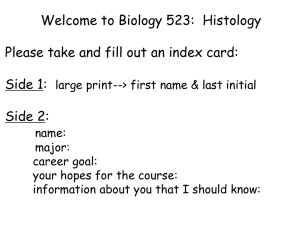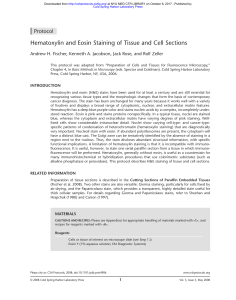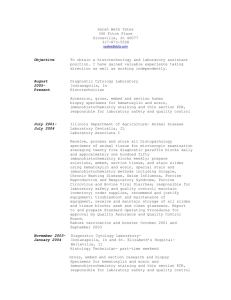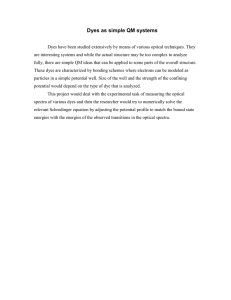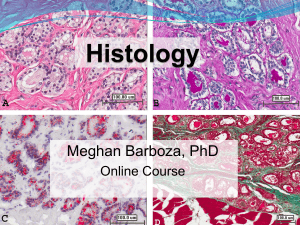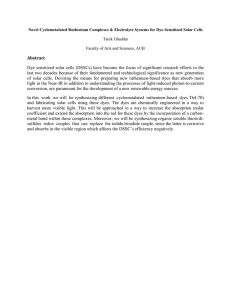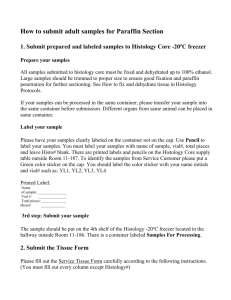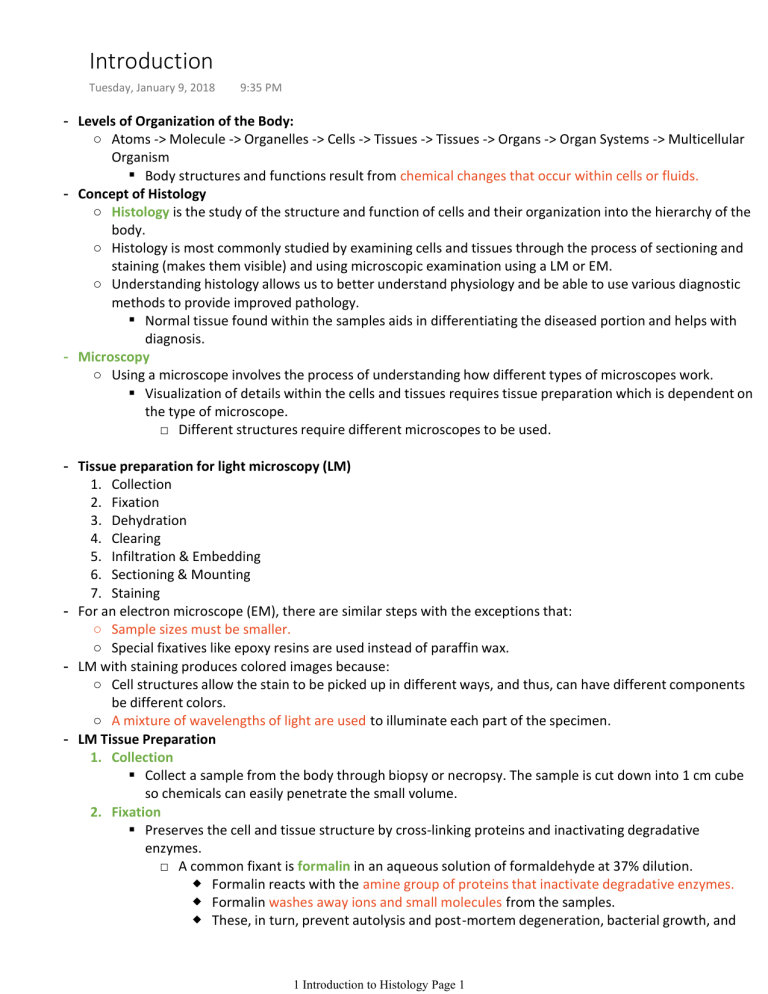
Introduction Tuesday, January 9, 2018 9:35 PM - Levels of Organization of the Body: ○ Atoms -> Molecule -> Organelles -> Cells -> Tissues -> Tissues -> Organs -> Organ Systems -> Multicellular Organism ▪ Body structures and functions result from chemical changes that occur within cells or fluids. - Concept of Histology ○ Histology is the study of the structure and function of cells and their organization into the hierarchy of the body. ○ Histology is most commonly studied by examining cells and tissues through the process of sectioning and staining (makes them visible) and using microscopic examination using a LM or EM. ○ Understanding histology allows us to better understand physiology and be able to use various diagnostic methods to provide improved pathology. ▪ Normal tissue found within the samples aids in differentiating the diseased portion and helps with diagnosis. - Microscopy ○ Using a microscope involves the process of understanding how different types of microscopes work. ▪ Visualization of details within the cells and tissues requires tissue preparation which is dependent on the type of microscope. □ Different structures require different microscopes to be used. - Tissue preparation for light microscopy (LM) 1. Collection 2. Fixation 3. Dehydration 4. Clearing 5. Infiltration & Embedding 6. Sectioning & Mounting 7. Staining - For an electron microscope (EM), there are similar steps with the exceptions that: ○ Sample sizes must be smaller. ○ Special fixatives like epoxy resins are used instead of paraffin wax. - LM with staining produces colored images because: ○ Cell structures allow the stain to be picked up in different ways, and thus, can have different components be different colors. ○ A mixture of wavelengths of light are used to illuminate each part of the specimen. - LM Tissue Preparation 1. Collection ▪ Collect a sample from the body through biopsy or necropsy. The sample is cut down into 1 cm cube so chemicals can easily penetrate the small volume. 2. Fixation ▪ Preserves the cell and tissue structure by cross-linking proteins and inactivating degradative enzymes. □ A common fixant is formalin in an aqueous solution of formaldehyde at 37% dilution. Formalin reacts with the amine group of proteins that inactivate degradative enzymes. Formalin washes away ions and small molecules from the samples. These, in turn, prevent autolysis and post-mortem degeneration, bacterial growth, and help preserve the structure of the tissue and readies it for dehydration. 1 Introduction to Histology Page 1 help preserve the structure of the tissue and readies it for dehydration. Formalin does not preserve lipid structures. □ An alternative to chemical fixation for the samples is to freeze them (normally done with compressed CO2 or liquid nitrogen). This process differs in that: ◊ It preserves lipids. ◊ Frozen tissue is sectioned in a cryostat, mounted in a glass slide, and then stained. ◊ It can provide immediate diagnostic information without the time taking process of fixation. Freezing might take barely 10 minutes to conduct whereas fixation can take from 12 to 60 hours. 3. Dehydration ▪ Removes tissue water. ▪ The tissue sample is transferred through a series of increasingly concentrated ethyl alcohol solutions, ending in absolute alcohol □ 4. Clearing ▪ Remove the alcohol. ▪ Clearing increases the refractive index of the tissue and make it easier to visualize. ▪ Clearing is also done to prepare the sample for embedding media (such as paraffin wax) to infiltrate the tissue. ▪ To clear the sample, the tissue has to be treated with a solvent that mixes with (miscible with) both alcohol and the embedding media that is to be used (most likely paraffin wax). □ Most samples use toluene for clearing or other similar organic solvents such as xylene, chloroform, or benzene. □ During this process, the alcohol used for dehydration is removed by the organic solvents. This is important since ethyl alcohol is immiscible with wax. 5. Infiltration & Embedding ▪ Infiltration □ Process where the tissue is placed in melted paraffin until it becomes infiltrated. □ The clearing solvent used evaporates in the oven temperature. ▪ Embedding □ The paraffin-infiltrated tissue is placed into a small mold with the melted paraffin and allowed to solidify into a small cube at room temp. 6. Sectioning (slicing) & Mounting ▪ Sectioning □ Very thin slices are cut from the paraffin-embedded tissue using a microtome. □ Each section is cut ~5 - 10 um in thickness normally. They can even be cut down to 2 um or less. 1 um = 1 x 10-6 m. ▪ Mounting □ The section is mounted onto a glass slide. □ The paraffin wax is removed using an organic solvent and tissue is rehydrated with decreasing concentration of alcohol (reverse of dehydration). □ The section is usually stained at this stage and a coverslip is applied to stop movement. 7. Staining ▪ Provides visual contrast and may help identify specific tissue components. □ Various dyes stain tissue components more or less selectively. They form salt linkages with 1 Introduction to Histology Page 2 □ Various dyes stain tissue components more or less selectively. They form salt linkages with oppositely charged tissues. ○ The risk with any of these steps is that there is a chance of introducing a foreign artifact into the sample. - Hematoxylin & Eosin (H&E) ○ H&E are the most commonly used stains for light microscopy. ▪ They behave like basic or acidic compounds. ▪ Hematoxylin: □ Behaves like a basic (cationic) dye. Caries a net + charge on its colored portion. Basic dyes are described by the general formula: dye+ Cl-. □ It stains acidic compounds of the cells and tissues called basophilic regions (base-loving). Basophilic molecules include: ◊ In the nucleus: DNA in Heterochromatin (condensed heterochromatin is dark blue color) Nucleolus – RNA in the nucleolus ◊ Ribosomes in the RER ◊ Glycosaminoglycans in the EC matrix Long chains of polysaccharides made by hundreds of disaccharide repeating units. □ Hematoxylin produces a blue/purple color. □ In pancreatic acinar cells, only hematoxylin is used. (Acinar cells means cells that look like a bunch of grapes) □ With hematoxylin, parts of the cell that include the nucleus and areas containing cytoplasmic RNA are heavily stained. □ Other basic dyes include: Methylene blue, Toluidine blue, and Thionine. These frequently react with polyanionic tissue components and impart to it, a color different from that of the dye itself. This instance is called metachromasia. ◊ Examples of metachromasia: Mast cell granules – Type of cell in the connective tissue. – There are several different types of mast cell granules within the cytoplasm throughout connective tissue. Some contain histamine, heparin, sulfates, and etc. Cartilage – Contains lots of proteoglycans and glycosaminoglycans. Mucin Amyloids ▪ Eosin □ Acts as an acidic (anionic) dye. □ Acid dyes carry a net - charge on the colored portion & generally given the formula: dye- Na+. □ Acidic dyes stain basic components with a net + charge and are called eosinophilic regions or 1 Introduction to Histology Page 3 □ Acidic dyes stain basic components with a net + charge and are called eosinophilic regions or acidophilic regions. Acidophilic molecules are usually: ◊ Proteins (cytoplasmic or EC) ◊ Cellular structures containing basic components similar such as some proteins with basic amino acids. Mitochondrion Most secretory vesicles Cytoplasmic filaments EC structures such as collagen and elastic fibers □ Eosin stains a pink/red/orange color. □ In pancreatic acinar cells, only eosin is used. □ Eosin has an overall staining effect. The nuclei are less conspicuous than with hematoxylin. □ Other acidic dyes include Orange G., Acid fuchsin, and aniline blue. 1 Introduction to Histology Page 4
